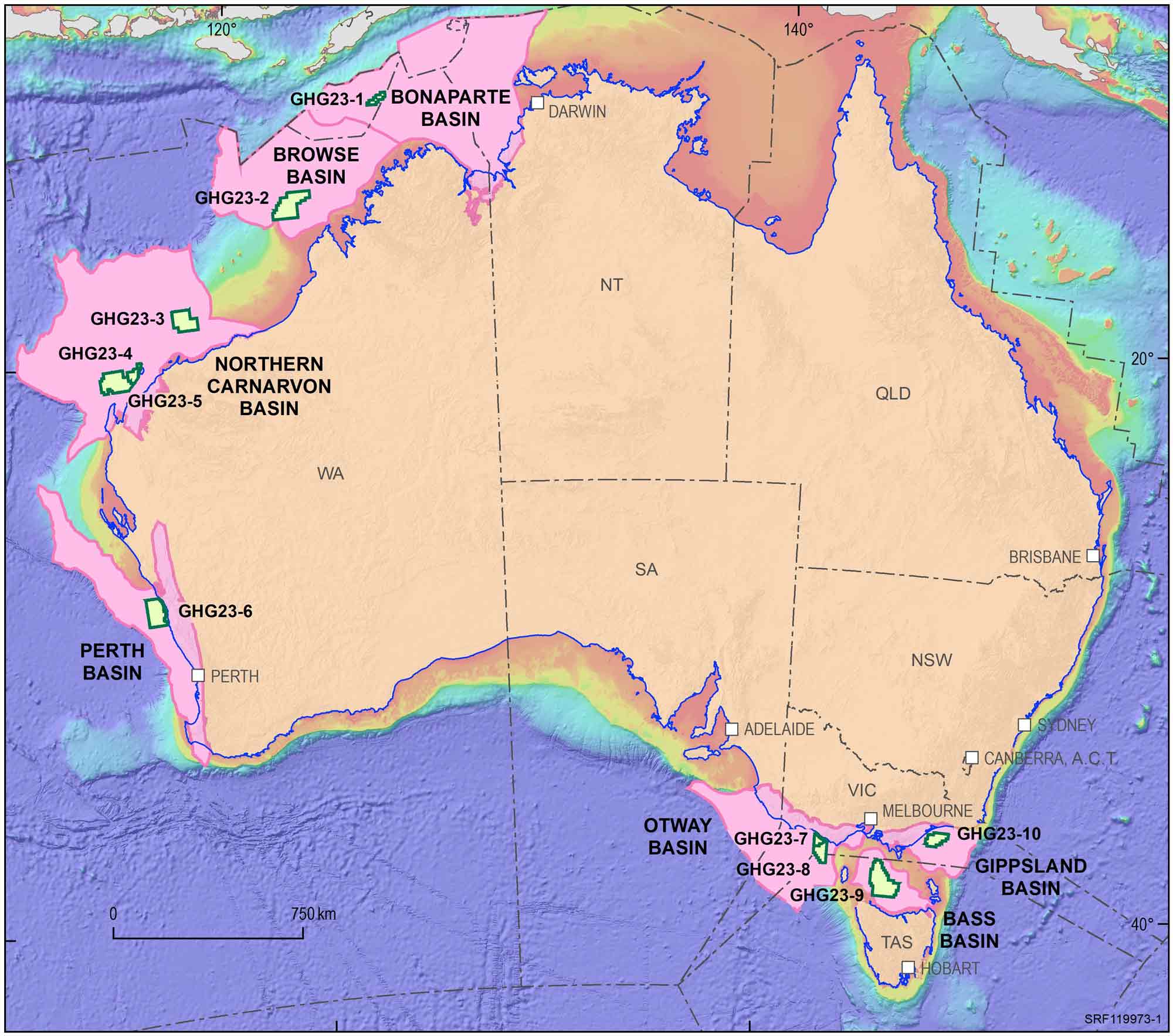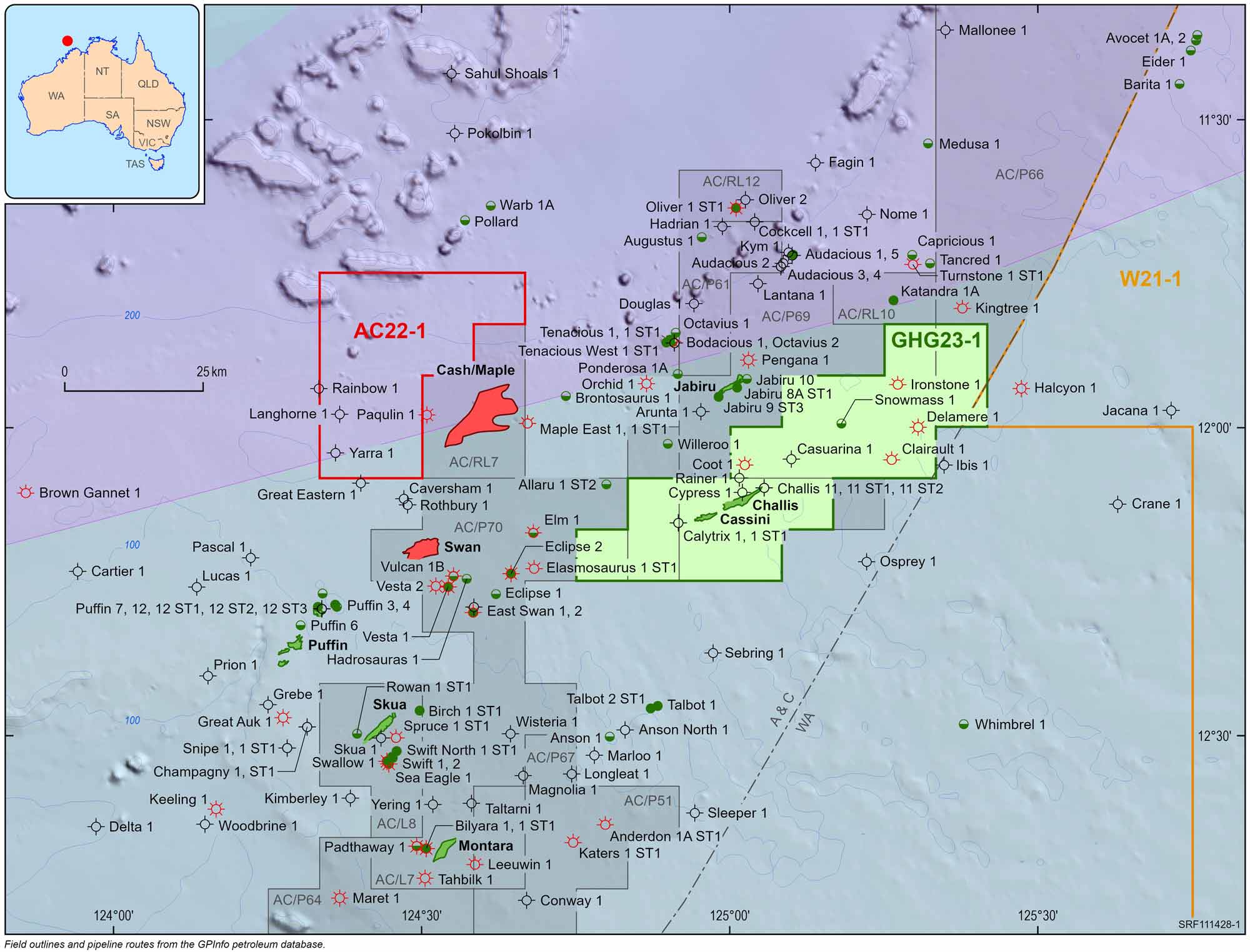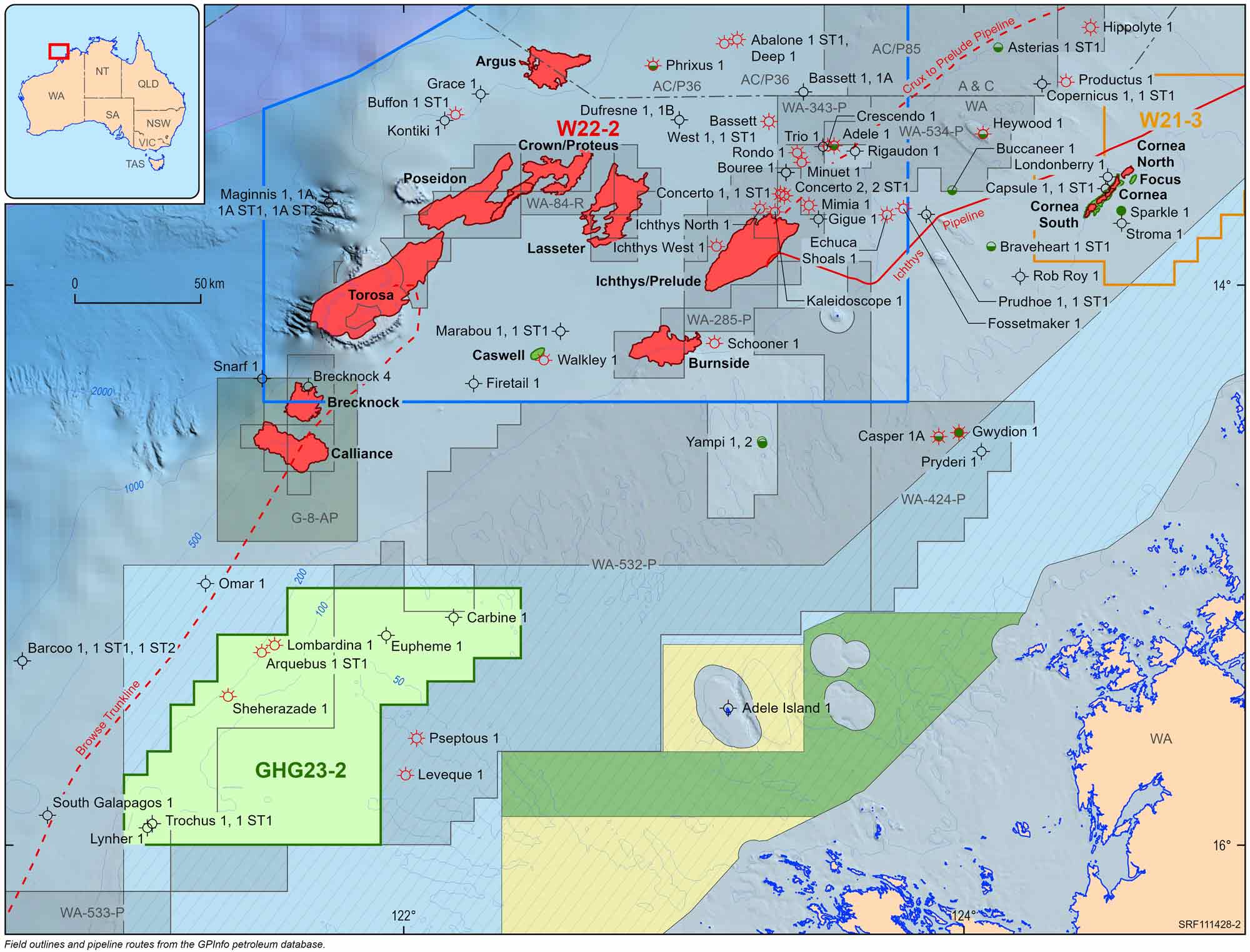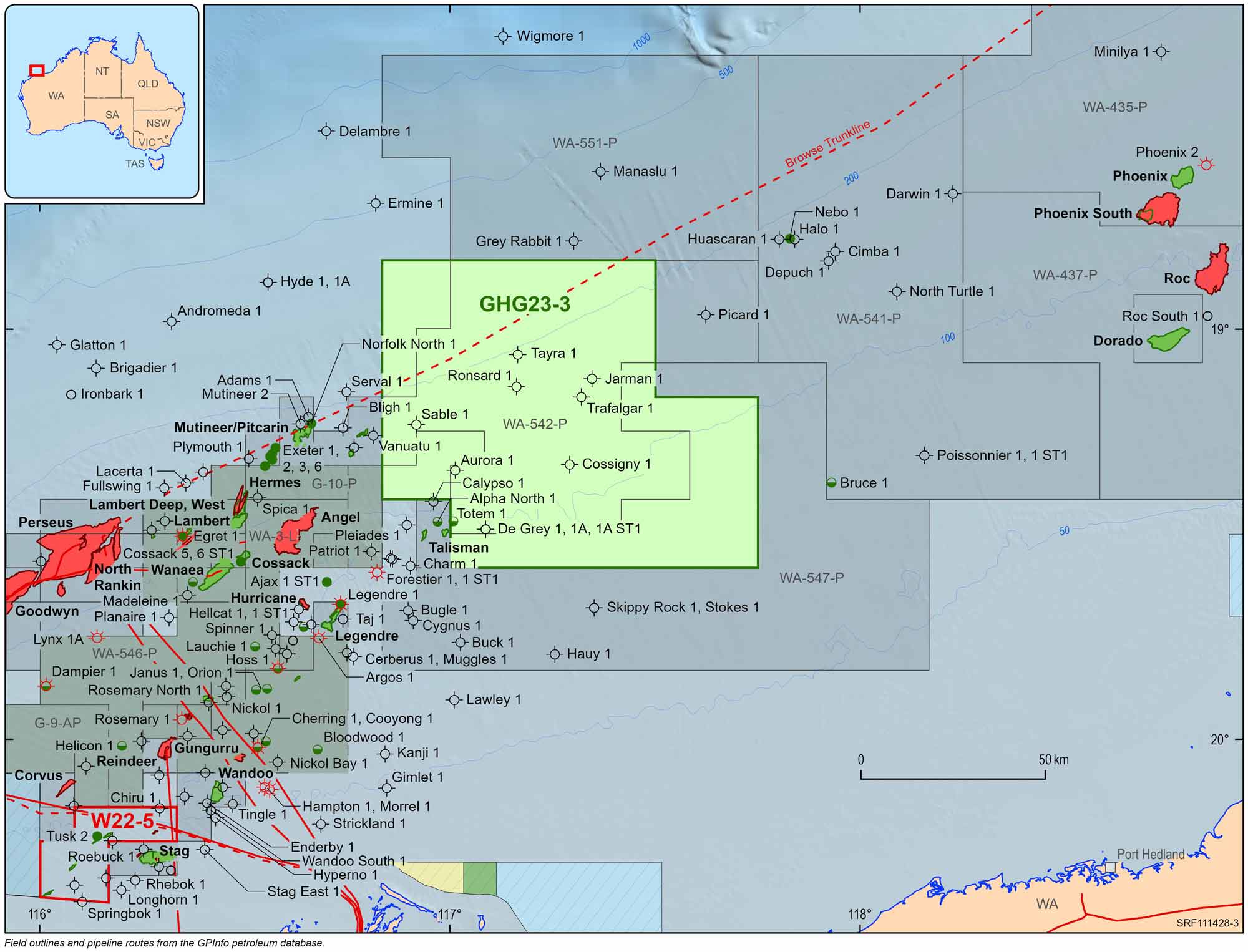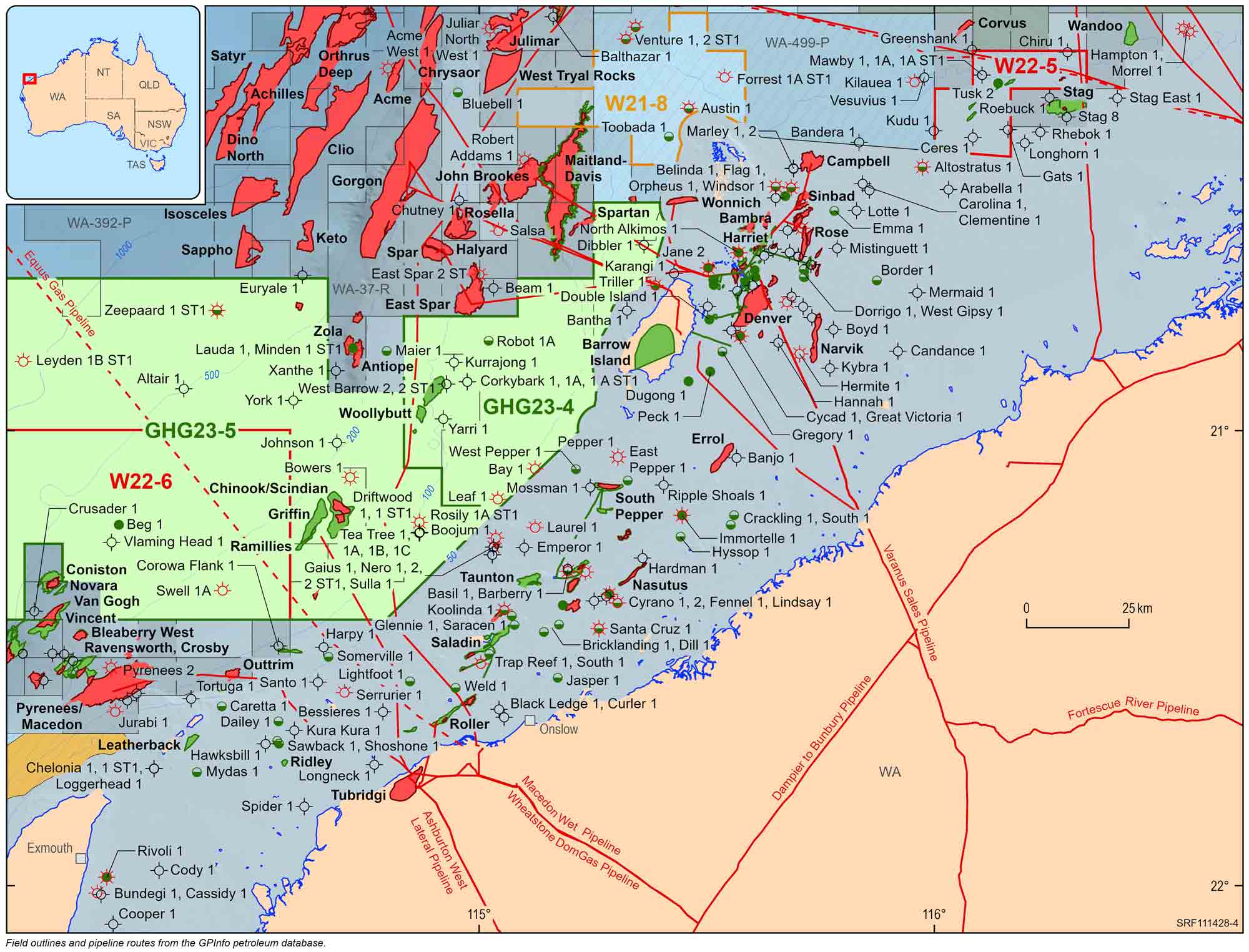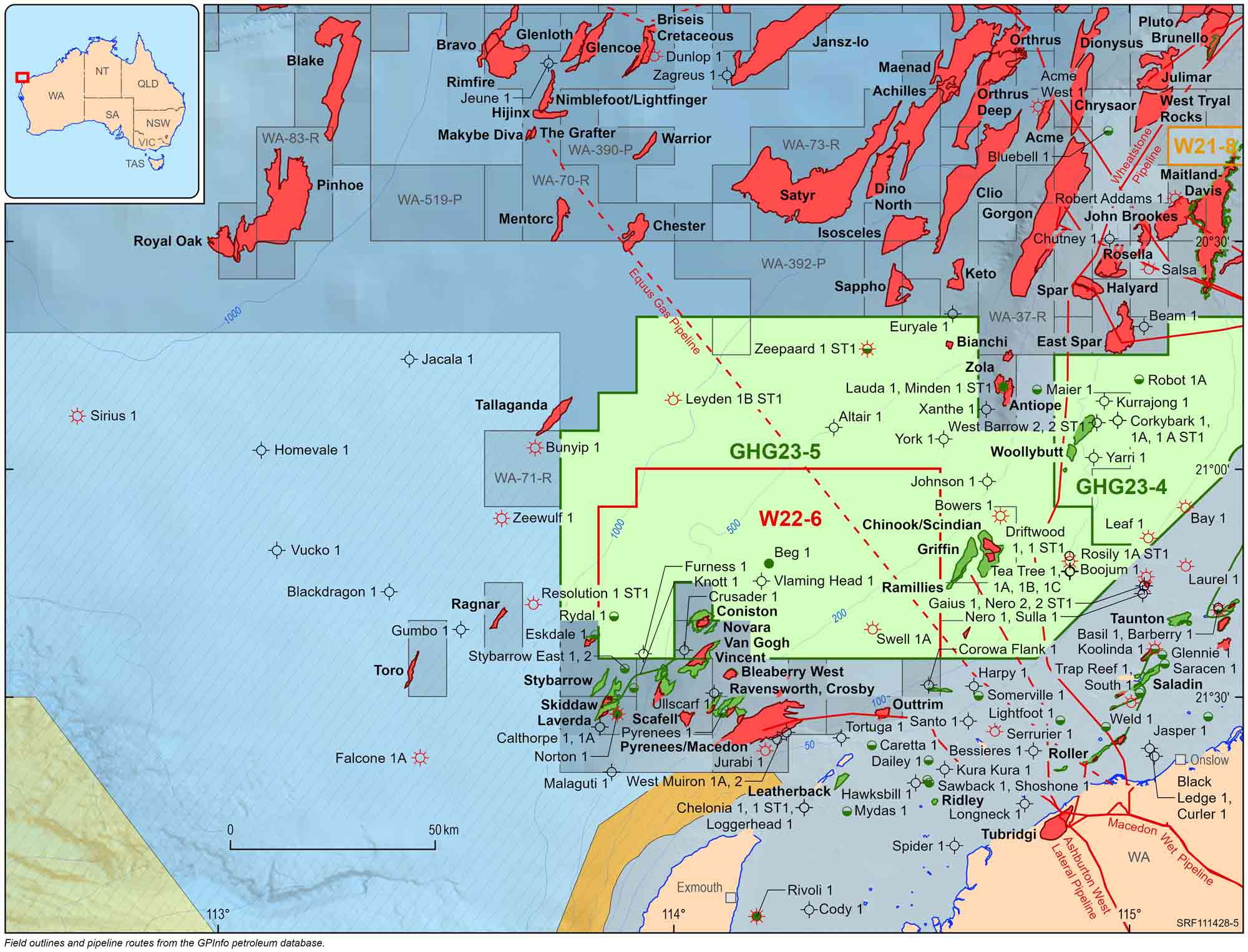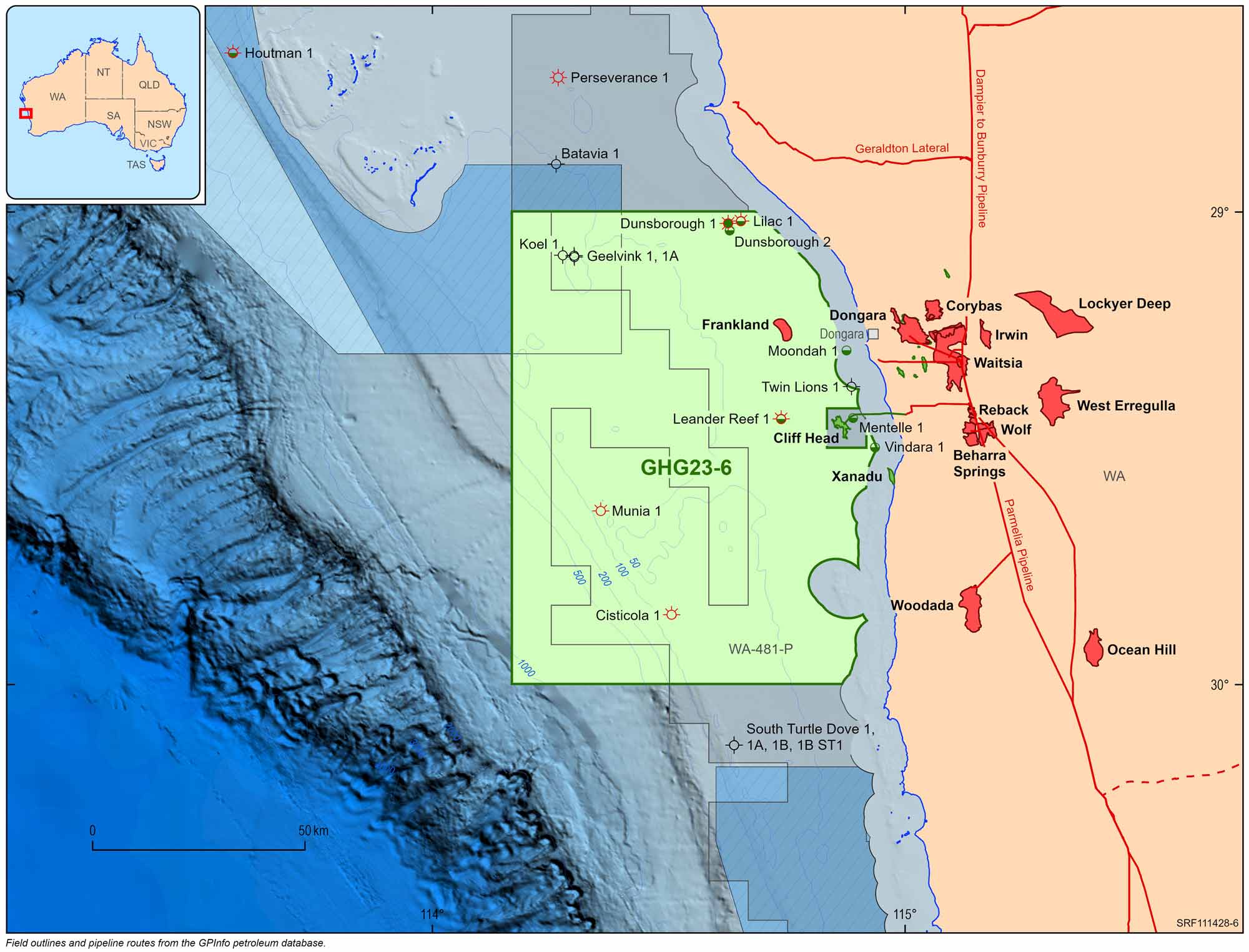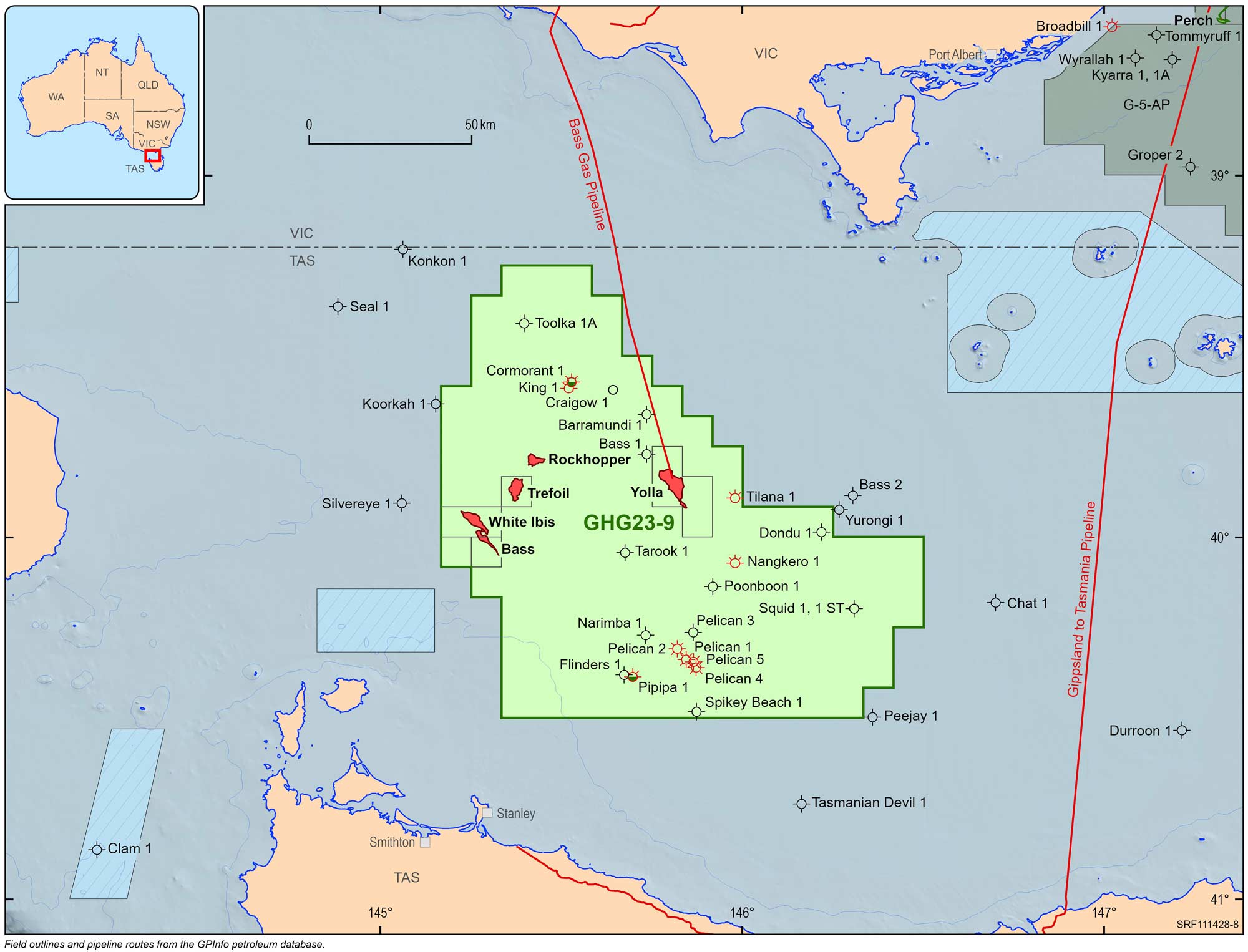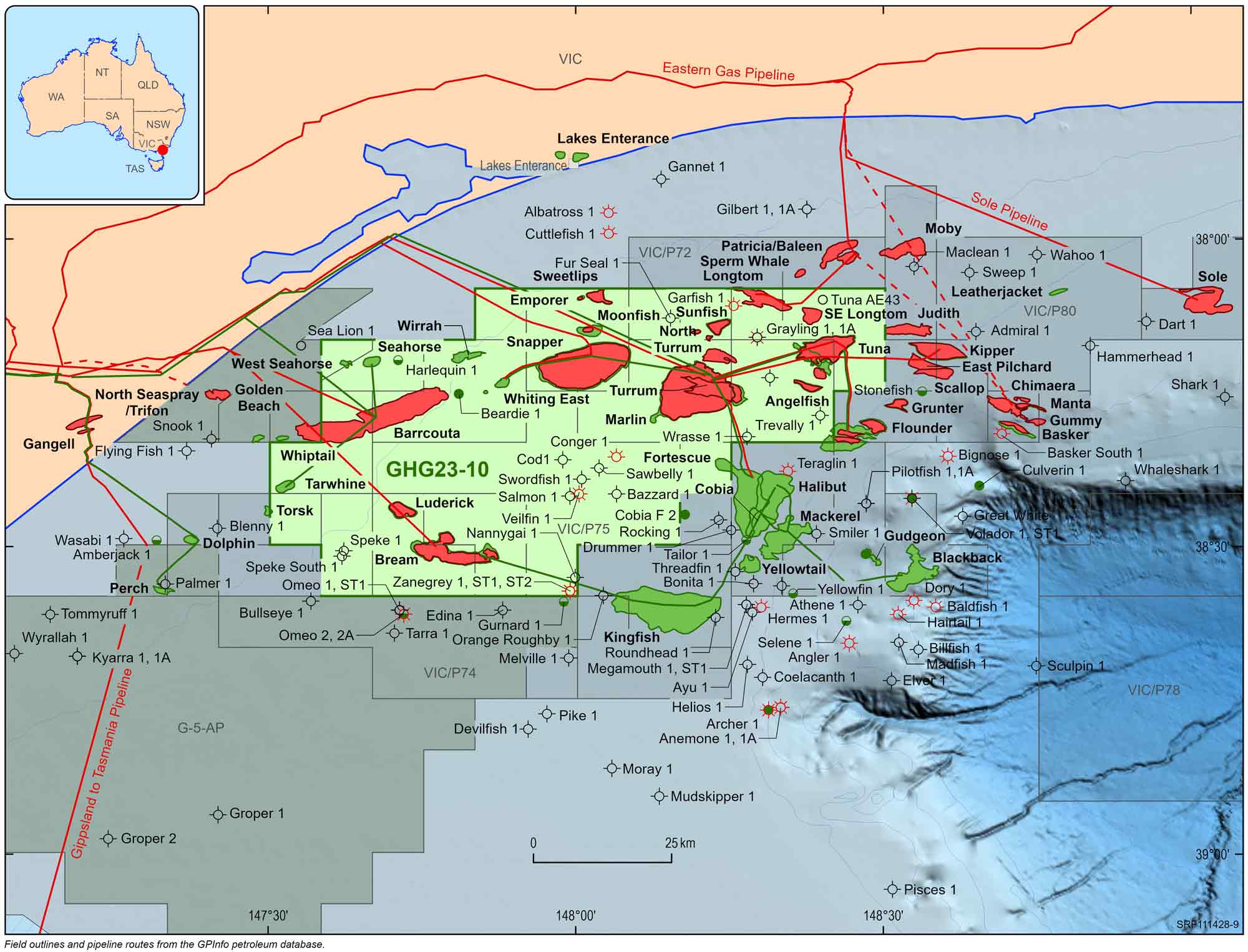2023 Greenhouse Gas Storage Release Areas
Page last updated:19 September 2023
The 2023 Offshore Greenhouse Gas Storage (GHG) Acreage Release comprises 10 areas located across seven sedimentary basins in Commonwealth waters including the Bonaparte, Browse, Northern Carnarvon, Perth, Otway, Bass and Gippsland basins. The areas are open for work program bidding until 28 November 2023. Companies awarded a permit must meet a range of requirements before starting any offshore exploration activities in Australian Commonwealth waters. We have partnered with the Department of Industry, Science and Resources to provide geological information to support this release. Please refer to the Department of Industry, Science and Resources for more information about the release areas, including maps, shapefiles, bidding instructions and the offshore GHG acreage release process.
Bonaparte Basin
GHG23-1 – Vulcan Sub-basin
- 18 graticular blocks
- Water depths 70–120 m
- Good well control, extensive 2D and 3D seismic coverage
- Potential CO2 sources: Darwin processing facilities; Bonaparte Basin field developments
- Storage targets: depleted fields (i.e. the Triassic hosted Challis and Cassini oil fields) and possible saline aquifers if suitable
Read more on the Bonaparte Basin Regional Geology
Browse Basin
GHG23-2 – Barcoo and Caswell sub-basins
- 115 graticular blocks
- Water depths 40–270 m
- Good well control, extensive 2D and some 3D seismic coverage
- Potential CO2 sources: future field developments
- Storage targets: Late Jurassic–Late Cretaceous saline aquifers and features such as the Carbine ponded turbidite complex and the long-migration dissolution trap on the Leveque Shelf (Chirinos et al. 2008)
Key studies:
- Browse Basin CO2 storage study conducted by Geoscience Australia.
- Chirinos et al. 2008. Site Characterisation Analysis for Potential CO2 Storage in the Browse Basin, North West Shelf, Australia. CO2CRC Publication RPT08-1014.
- Detailed studies of the CO2 storage potential of targets in the release area by the CO2CRC (2005–2008).
Read more on the Browse Basin Regional Geology
Northern Carnarvon Basin
GHG23-3 – Beagle Sub-basin
- 83 graticular blocks
- Water depths 70–370 m
- Good well control, extensive 2D and some 3D seismic coverage
- Potential CO2 sources: onshore industrial region
- Storage target: Middle Jurassic to Lower Cretaceous sandstones including the Legendre Formation
GHG23-4 – Barrow Sub-basin
- 21 full and 14 part graticular blocks
- Water depths 20–120 m
- Good well control, extensive 2D and 3D seismic coverage
- Potential CO2 sources: field developments in the basin
- Storage target: Barrow Group saline aquifers and depleted field (Woollybutt)
Key studies:
- Gibson-Poole et al. 2004. Geological storage in the Barrow Sub-basin.
GHG23-5 – Barrow and Exmouth sub-basins
- 103 full and 5 part graticular blocks
- Water depths 60 – 1100 m
- Good well control, extensive 2D and 3D seismic coverage
- Potential CO2 sources: field developments in the basin and onshore industrial sources
- Storage targets: Depleted fields (i.e. Griffin and Chinook) and saline aquifers in the Upper Jurassic to Lower Cretaceous interval.
Key studies:
Read more on the Northern Carnarvon Basin Regional Geology
Perth Basin
GHG23-6 – Abrolhos Sub-basin
- 89 full and 19 part graticular blocks
- Water depths 10–1200 m
- Reasonable well control, extensive 2D and some 3D seismic coverage
- Potential CO2 sources: onshore industrial activity including the potential Mid West Clean Energy project
- Storage targets: structural traps and saline aquifers, mostly in the Permian section
Key studies:
- Jones et al. 2011. New exploration opportunities in the offshore northern Perth Basin.
- Jorgensen et al. 2011. Offshore Northern Perth Basin Well Folio.
- Langhi et al. 2012. Geomechanical modelling of trap integrity in the northern offshore Perth Basin.
- Rollet et al. 2013. New exploration opportunities in the offshore Houtman and Abrolhos sub-basins, northern Perth Basin.
Read more on the Perth Basin Regional Geology
Otway Basin
GHG23-7 and GHG23-8 – Shipwreck Trough
GHG23-7
- 13 full and 9 part graticular blocks
- Water depths 40–90 m
- Excellent well control and 3D seismic coverage
GHG23-8
- 45 graticular blocks
- Water depths 100–1100 m
- Excellent well control and 3D seismic coverage
- Potential CO2 sources: gas field developments in the basin, and industrial sources at Geelong and Portland
- Storage targets: Cretaceous sandstones, primarily the Flaxman and Warre formations.
Key studies:
- Gibson-Poole et al. 2008. Review of geological storage opportunities for carbon capture and storage (CCS) in Victoria.
- Geoscience Australia’s Deepwater Otway Basin Project
Read more on the Otway Basin Regional Geology
Bass Basin
GHG23-9 – Cape Wickham Sub-basin
- 152 graticular blocks
- Water depths 50–80 m
- Good well control, extensive 2D and some 3D seismic
- Potential CO2 sources: Field developments in the basin and industrial centres in south-eastern Victoria
- Storage targets: Depleted fields and dry structures, Eastern View Formation (Upper Cretaceous to Eocene)
Key studies:
- Arian et al. 2011. Carbon dioxide (CO2) geological storage potential of the Bass Basin.
- Arian et al. 2008. Porosity trends and reservoir quality in the Bass Basin.
- Blevin et al. 2003. Petroleum Geology of the Bass Basin.
Read more on the Bass Basin Regional Geology
Gippsland Basin
GHG23-10 – Central Deep
- 51 graticular blocks
- Water depths 30 – 90 m
- Excellent well control and 3D seismic coverage
- Potential CO2 sources: field developments in the basin and onshore industrial sources
- Storage targets: primarily depleted fields reservoired in the upper Latrobe Group (Upper Cretaceous to Eocene) and possible deeper seated saline aquifers
Key studies:
- Langford, R.P. (Editor). 2016. Carbon dioxide storage potential of the Gippsland Basin
- Gibson-Poole et al. 2008. Site characterisation of a basin-scale CO2 geological storage system: Gippsland Basin, southeast Australia.
- Goldie Divko et al. 2009. Geological carbon storage in the Gippsland Basin, Australia: Containment potential.
- Blevin et al. 2013. Survey GDPI10 Interpretation Project, Southern Flank, Gippsland Basin.
Read more on the Gippsland Basin Regional Geology
Further information
- Search the interactive National Offshore Petroleum Information Management System (NOPIMS) database for well and survey information
- View the 2023 release areas interactively through the Geoscience Australia Portal that hosts a range of geoscientific data
- Learn more about Carbon Capture and Storage (CCS) via our webpage, that includes links to research into the potential for the geological storage of greenhouse gases in Australia
- Explore our regional geological overviews for Acreage Release basins
Past releases
The 2021 Offshore Greenhouse Gas Storage (GHG) Acreage Release comprised 5 areas located across three sedimentary basins in Commonwealth waters offshore of Western Australia and the Northern Territory. Bidding for the 2021 GHG Acreage Release closed on 10 March 2022, all areas were subsequently awarded as greenhouse gas storage assessment permits.
